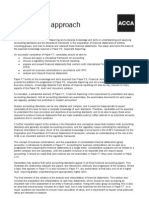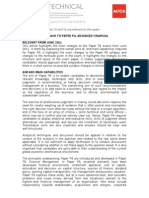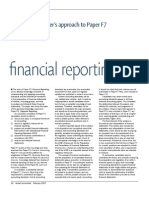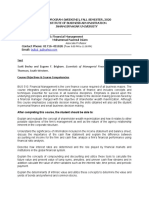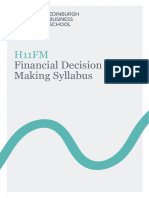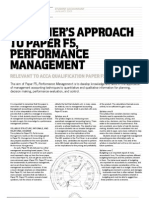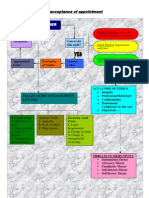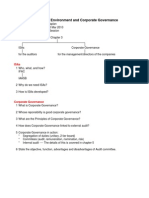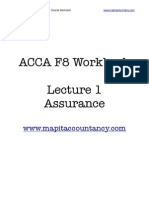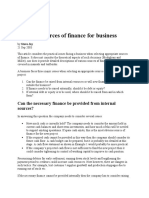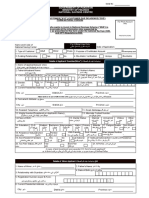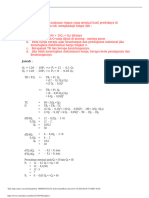Head 0307
Head 0307
Uploaded by
Pawan_Vaswani_9863Copyright:
Available Formats
Head 0307
Head 0307
Uploaded by
Pawan_Vaswani_9863Copyright
Available Formats
Share this document
Did you find this document useful?
Is this content inappropriate?
Copyright:
Available Formats
Head 0307
Head 0307
Uploaded by
Pawan_Vaswani_9863Copyright:
Available Formats
Qualification
new ACCA
examiner’s approach to Paper F9
financial
management
This article explains the approach to The aim of Paper F9 is to develop the the achievement of business objectives, the
examining Paper F9, Financial Management, knowledge and skills expected of a finance syllabus explores the link between objectives,
and clarifies any uncertainty regarding the manager – in relation to investment, financing, strategy, and stakeholders. Financial
content of the syllabus. For students planning and dividend decisions. The syllabus is management decisions are influenced by
to take this paper, a good place to start designed to equip candidates with the skills factors external to the organisation, so
is the ACCA website, where the Paper F9 that would be expected from a finance the syllabus also considers the impact of
Syllabus and Study Guide, together with the manager responsible for the finance function of government economic policy in key areas such
Pilot Paper and its Suggested Answers can a business. as interest rates and exchange rates, as well
be found. From a relational point of view, Paper F9 as the nature and role of financial markets
builds on knowledge gained through studying and institutions.
Paper F2, Management Accounting, and The next three sections of the syllabus look
also prepares candidates for further study of at working capital management, investment
financial management in Paper P4, Advanced appraisal, and sources of business finance.
Financial Management. Students who are Managing working capital is a key concern
exempt from Paper F2 should ensure that they of the finance manager, who must balance
are familiar with its content by referring to its the conflicting objectives of profitability and
Syllabus and Study Guide. liquidity. Investment decisions constitute
one of the three decision areas of financial
Syllabus and Study Guide management, and the finance manager must
The first two sections of the syllabus consider be able to identify relevant cash flows, and
the role and purpose of the finance manager, evaluate a proposed investment and its effect
and the financial management environment. on the organisation. Financing decisions,
As financial management decisions support another of the three decision areas, are
42 student accountant March 2007
Qualification
new ACCA
considered in the business finance section of For students planning to take this The Pilot Paper
the syllabus. A finance manager must be able The Pilot Paper illustrates the kind of
to identify and evaluate the most appropriate paper, one place to start to clarify any questions that will be set. A feel for my style
sources of finance to meet organisational uncertainty regarding the content of writing can be gained by reviewing Paper
financing needs. 2.4, Financial Management and Control exam
One of the key relationships in financial
of the syllabus is the ACCA website, questions from 2003 onwards.
management is that between risk and return, where the Paper F9 Syllabus and Study Question 1 in the Pilot Paper requires
and the sixth section of the syllabus looks Guide, together with the Pilot Paper calculation of the weighted average cost of
at the cost of capital and the influence of capital (WACC) of a listed company, and
capital structure on the average cost of capital. and Suggested Answers can be found. a discussion of whether, theoretically, a
Candidates must be able to calculate the minimum WACC can be found. It also requires
cost of individual sources of finance and the an evaluation of the effect of a loan note issue
average cost of organisational finance, and identify and evaluate alternative sources of on three key ratios.
critically discuss whether financing choices business finance Question 2 requires a discussion of
can reduce the average cost of capital and explain and calculate cost of capital and the types of foreign currency risk and an
thereby increase the value of the organisation the factors that affect it explanation of how inflation rates can be used
as a whole. discuss and apply principles of business to forecast exchange rates. It also requires a
The next section of the syllabus looks at and asset valuations comparative evaluation of a money-market
business valuation. Candidates must be able explain and apply risk management hedge and a forward market hedge, and an
to value financial assets, such as ordinary techniques in business. explanation of how currency futures can be
shares and bonds, and a business as a whole. used to hedge foreign exchange risk.
Evaluation of financial choices is a key theme You will recognise that these eight capabilities Question 3 requires an evaluation of a
here and candidates are expected to be reflect the eight sections of the syllabus. proposed change in credit policy, application
able to discuss, as well as apply, a range of of the Miller–Orr model, and an explanation
valuation methods. Format of the exam of the key areas of accounts receivable
The final section of the syllabus looks The three-hour exam consists of four management. It also requires a discussion
at risk management in relation to foreign questions, all of which are compulsory and of the key factors influencing working capital
currency risk and interest rate risk. Candidates of equal length. Each question is worth funding policy.
should have an awareness of the different 25 marks. Question 4 requires calculation of net
types of foreign currency and interest rate risk, This format is commonly adopted by other present value and return on capital employed,
and of the possible reasons why these arise. papers at this level and means that candidates as well as a discussion of the strengths and
Candidates will need to be able to will not need to spend time choosing which weaknesses of the internal rate of return
evaluate and apply both internal and external question to answer. An extra 15 minutes of method.
risk management (hedging) methods, using reading and preparation time is given at the
the methods identified in the syllabus. Note start of the exam. Conclusion
that evaluation of derivative-based hedging Each question will have both discussion In order to pass this paper, candidates
methods – such as those using futures, and calculation elements. The balance should:
options, and swaps – is not required. between discussion and calculation will be clearly understand the objectives of Paper
similar to the balance in the Pilot Paper. F9, as explained above, and in the Syllabus
Main capabilities The topic areas covered by each question and in the accompanying Study Guide
The main capabilities are described in the are not fixed and all areas of the syllabus read and study thoroughly a suitable
Syllabus. Candidates who successfully pass are examinable. financial management textbook
the Paper F9 exam will be able to: No sections of the syllabus should be read relevant articles in student
discuss the role and purpose of the neglected during study, since no one section is accountant
financial management function more important than another. practise exam-standard and exam-style
assess and discuss the impact of the Each exam paper will contain tables questions on a regular basis
economic environment on financial of discount factors and annuity factors, be able to communicate their
management together with a formulae sheet, as in the Pilot understanding clearly in an exam
discuss and apply working capital Paper. Candidates must ensure that they context.
management techniques are familiar with the formulae given in the
carry out effective investment appraisal formulae sheet. Antony Head is examiner for Paper F9
44 student accountant March 2007
You might also like
- Case 51 - SolDocument20 pagesCase 51 - SolArdian Syah75% (4)
- GB550 Course PreviewDocument8 pagesGB550 Course PreviewNatalie Conklin100% (1)
- Advanced Financial Accounting & Reporting Business CombinationDocument12 pagesAdvanced Financial Accounting & Reporting Business CombinationJunel PlanosNo ratings yet
- Acca F9 Tec ArtDocument82 pagesAcca F9 Tec ArtFloyd DaltonNo ratings yet
- F 9 TranscriptDocument14 pagesF 9 Transcriptg_shivam_3No ratings yet
- Chapter 5 - Financial Management and Policies - SyllabusDocument7 pagesChapter 5 - Financial Management and Policies - SyllabusharithraaNo ratings yet
- Jaipuria Institute of Management, Lucknow Post Graduate Diploma in Management THIRD TRIMESTER (2013-2014)Document6 pagesJaipuria Institute of Management, Lucknow Post Graduate Diploma in Management THIRD TRIMESTER (2013-2014)saah007No ratings yet
- Examiners ApproachDocument3 pagesExaminers ApproachpikhtNo ratings yet
- Advanced Financial Management Course OutlineDocument3 pagesAdvanced Financial Management Course OutlineMan TK100% (2)
- SFAD-FIN601 Course OutlineDocument10 pagesSFAD-FIN601 Course OutlineMadhu Kumari VaswaniNo ratings yet
- Advanced Finance For Decision MakersDocument5 pagesAdvanced Finance For Decision Makersatomicslash3No ratings yet
- Financial Management 1Document5 pagesFinancial Management 1Nishant ShuklaNo ratings yet
- Examiner'S Approach To Paper P4, Advanced Financial Management Relevant From June 2011Document6 pagesExaminer'S Approach To Paper P4, Advanced Financial Management Relevant From June 2011Mohammad OsmanNo ratings yet
- SFAD - Course OutlineDocument10 pagesSFAD - Course OutlineMuhammad Shariq SiddiquiNo ratings yet
- Examiner's Approach Interview: F7 - Financial ReportingDocument13 pagesExaminer's Approach Interview: F7 - Financial ReportingHarrison KoteyNo ratings yet
- MBM 804 Module OutlineDocument6 pagesMBM 804 Module OutlineAutorix InvestmentsNo ratings yet
- FIN202 Outline Final (New)Document10 pagesFIN202 Outline Final (New)abdulsammad13690No ratings yet
- Mba DescripDocument24 pagesMba DescripsikandarbatchaNo ratings yet
- Exam Approach Interview: P4 Advanced Financial ManagementDocument15 pagesExam Approach Interview: P4 Advanced Financial ManagementChandu SagiliNo ratings yet
- Steve Scott's Approach To f7Document2 pagesSteve Scott's Approach To f7Zohaib AslamNo ratings yet
- Course Title: Advanced Financial Management Course Code: MBA 5061 Credit Hour: 2 Ects: 5 Course DescriptionDocument3 pagesCourse Title: Advanced Financial Management Course Code: MBA 5061 Credit Hour: 2 Ects: 5 Course DescriptionAbdu MohammedNo ratings yet
- GID15713037-SBR GRPB Lesson - 1Document28 pagesGID15713037-SBR GRPB Lesson - 1Kat LeighNo ratings yet
- Course SyllabusDocument2 pagesCourse SyllabusManpreet ToorNo ratings yet
- II Semester 2016-17 Course Handout BAV ECON F355Document19 pagesII Semester 2016-17 Course Handout BAV ECON F355Tushit ThakkarNo ratings yet
- Mas 3 Module 1 Fs AnalysisDocument19 pagesMas 3 Module 1 Fs AnalysisHazel Jane EsclamadaNo ratings yet
- AC3059 Financial ManagementDocument4 pagesAC3059 Financial ManagementJ TNo ratings yet
- Econ F355Document21 pagesEcon F355personaluse0071No ratings yet
- AC3059 Financial ManagementDocument4 pagesAC3059 Financial ManagementSaad AtharNo ratings yet
- Instructor-In-Charge: Prof. Niranjan Swain: Niranjanswain@pilani - Bits-Pilani.c.inDocument13 pagesInstructor-In-Charge: Prof. Niranjan Swain: Niranjanswain@pilani - Bits-Pilani.c.inSiddharth MehtaNo ratings yet
- H11FMDocument9 pagesH11FMsimlaislamNo ratings yet
- Principles of FinanceDocument5 pagesPrinciples of FinanceBimo SujatmokoNo ratings yet
- Course Outline Advanced Corporate Finance 2019Document8 pagesCourse Outline Advanced Corporate Finance 2019Ali Shaharyar ShigriNo ratings yet
- Sa Oct12 p4 ApproachDocument5 pagesSa Oct12 p4 ApproachAlisha TuladharNo ratings yet
- BUS 510 Course OutlineDocument2 pagesBUS 510 Course OutlineNoor NabiNo ratings yet
- Scott Besley and Eugene F. Brigham. Essentials of Managerial Finance. 14 Edition. USA: Thomson, South-WesternDocument2 pagesScott Besley and Eugene F. Brigham. Essentials of Managerial Finance. 14 Edition. USA: Thomson, South-WesternominNo ratings yet
- Corporatte Finance OutlineDocument7 pagesCorporatte Finance OutlinemehwishNo ratings yet
- AF5312Document4 pagesAF5312Chin LNo ratings yet
- FM S24-J25 Syllabus and Study Guide - FinalDocument20 pagesFM S24-J25 Syllabus and Study Guide - Finalyaswanthr12No ratings yet
- Trilochan@xlri - Ac.in: Standardized Outline For CoursesDocument5 pagesTrilochan@xlri - Ac.in: Standardized Outline For CoursesAtul AnandNo ratings yet
- F2 TranscriptDocument16 pagesF2 TranscriptKevin KausiyoNo ratings yet
- Book Reviews: I.M. Pandey (Ed.), Financial Management, Eleventh ISBN: 978-8125937142 (Paperback)Document2 pagesBook Reviews: I.M. Pandey (Ed.), Financial Management, Eleventh ISBN: 978-8125937142 (Paperback)ihda0farhatun0nisakNo ratings yet
- Advanced Financial Management AFM - Technical ArticlesDocument132 pagesAdvanced Financial Management AFM - Technical ArticlesWaleedSultanNo ratings yet
- FMG MBA 2025 Spring - Course Outline Updated 1 Jan 2023 S.M. Ali.Document15 pagesFMG MBA 2025 Spring - Course Outline Updated 1 Jan 2023 S.M. Ali.Umer NaeemNo ratings yet
- Investment & Portfolio Mgt. SyllabusDocument7 pagesInvestment & Portfolio Mgt. SyllabusEmi Yunzal75% (4)
- H11FM RebrandDocument9 pagesH11FM Rebrandrajbhandarisamyukta03No ratings yet
- Ollege OF Usiness AND Ccountancy: Msmagueflor@wesleyan - Edu.phDocument11 pagesOllege OF Usiness AND Ccountancy: Msmagueflor@wesleyan - Edu.phErlinda NavalloNo ratings yet
- FN2191 Commentary 2022Document27 pagesFN2191 Commentary 2022slimshadyNo ratings yet
- Business Finance OutlineDocument4 pagesBusiness Finance OutlineSalahuddin SultanNo ratings yet
- Questions OadsDocument12 pagesQuestions OadsMuhammad ShaheerNo ratings yet
- Course Syllabus: MGT 142 (FDocument4 pagesCourse Syllabus: MGT 142 (FMaria Romelyn MontajesNo ratings yet
- Institute of Management Sciences Bahauddin Zakariya University (Multan) Course Outline: Strategic Financial ManagementDocument4 pagesInstitute of Management Sciences Bahauddin Zakariya University (Multan) Course Outline: Strategic Financial ManagementJarhan AzeemNo ratings yet
- MGT402 - MAA - Course OutlineDocument6 pagesMGT402 - MAA - Course OutlineRajesh SinghNo ratings yet
- FN2191 Commentary 2020Document13 pagesFN2191 Commentary 2020slimshadyNo ratings yet
- Examiner's Approach To Paper f5, Performance ManagementDocument2 pagesExaminer's Approach To Paper f5, Performance ManagementMadhuka RanmaleeNo ratings yet
- Tools Assignments 10Document10 pagesTools Assignments 10Hongyi-George SongNo ratings yet
- AF5115 Jul 2014Document3 pagesAF5115 Jul 2014AwesomeNo ratings yet
- FOF Spring 20212 Outline 05032022 113248pmDocument8 pagesFOF Spring 20212 Outline 05032022 113248pmsikander jalalNo ratings yet
- Translating Strategy into Shareholder Value: A Company-Wide Approach to Value CreationFrom EverandTranslating Strategy into Shareholder Value: A Company-Wide Approach to Value CreationNo ratings yet
- Expert Financial Analysis: Strategies for Professional SuccessFrom EverandExpert Financial Analysis: Strategies for Professional SuccessNo ratings yet
- An Introduction to Stocks, Trading Markets and Corporate Behavior: Student EditionFrom EverandAn Introduction to Stocks, Trading Markets and Corporate Behavior: Student EditionRating: 3 out of 5 stars3/5 (2)
- Chapter 5-Ethics and Acceptance of Appointment: TenderDocument1 pageChapter 5-Ethics and Acceptance of Appointment: TenderPawan_Vaswani_9863No ratings yet
- Assurance Engagement: Carried OutDocument1 pageAssurance Engagement: Carried OutPawan_Vaswani_9863No ratings yet
- Chapter 3 Regulatory Environment and Corporate GovernanceDocument1 pageChapter 3 Regulatory Environment and Corporate GovernancePawan_Vaswani_9863No ratings yet
- F8 Workbook Questions 1.1 PDFDocument75 pagesF8 Workbook Questions 1.1 PDFPawan_Vaswani_9863No ratings yet
- Sa Oct09 Garrett2Document4 pagesSa Oct09 Garrett2Pawan_Vaswani_9863No ratings yet
- Cost of ,: CapitalDocument6 pagesCost of ,: Capitalarmin.sarfarazNo ratings yet
- Selecting Sources of Finance For Business: Can The Necessary Finance Be Provided From Internal Sources?Document6 pagesSelecting Sources of Finance For Business: Can The Necessary Finance Be Provided From Internal Sources?Pawan_Vaswani_9863No ratings yet
- Content Dam Acca Global PDF-Students 2012s Sa Mar11 f9v2Document8 pagesContent Dam Acca Global PDF-Students 2012s Sa Mar11 f9v2Guna TripathiNo ratings yet
- ACCA F9 Past Paper AnalysisDocument6 pagesACCA F9 Past Paper AnalysisPawan_Vaswani_9863100% (1)
- ACCA F9 Introduction To The PaperDocument5 pagesACCA F9 Introduction To The PaperPawan_Vaswani_9863No ratings yet
- Offshore Banking Secrets & Lies - GlobalBanksDocument38 pagesOffshore Banking Secrets & Lies - GlobalBanksboulayebusinetNo ratings yet
- The Type of Value and Its Definition Constitute Important Assignment Elements That Must Be Determined As Part of Problem IdentificationDocument5 pagesThe Type of Value and Its Definition Constitute Important Assignment Elements That Must Be Determined As Part of Problem Identificationtolha ramadhaniNo ratings yet
- L5 Petroleum ConcessionDocument21 pagesL5 Petroleum ConcessionImran AhmedNo ratings yet
- Instruction Sheet PDFDocument3 pagesInstruction Sheet PDFKevin KennedyNo ratings yet
- ATR - Confused How To Decode A Breakout or A Breakdown - Use ATR For Winning Trade - The Economic TimesDocument3 pagesATR - Confused How To Decode A Breakout or A Breakdown - Use ATR For Winning Trade - The Economic Timesscreen1 recordNo ratings yet
- Business ProposalDocument4 pagesBusiness Proposalsunilkumar31No ratings yet
- CH 16Document11 pagesCH 16Fahad Javaid50% (2)
- Challenges Faced by Interest - Free Banks in EthiopiaDocument17 pagesChallenges Faced by Interest - Free Banks in EthiopiaEle TekNo ratings yet
- Government of Pakistan Ministry of Finance National Savings CentreDocument2 pagesGovernment of Pakistan Ministry of Finance National Savings CentreSalman ArshadNo ratings yet
- L3 L5Document15 pagesL3 L5RomeNo ratings yet
- EDP)Document2 pagesEDP)02 - CM Ankita AdamNo ratings yet
- AP - FI-MM Intigration - Complete DocumentDocument151 pagesAP - FI-MM Intigration - Complete Documentzabiullah1243No ratings yet
- SoalDocument9 pagesSoalMuhamad AdityaNo ratings yet
- Lease AgreementDocument21 pagesLease Agreementaks12368No ratings yet
- Cost of Debt Calculations PDFDocument2 pagesCost of Debt Calculations PDFhukaNo ratings yet
- Marlene Davis Bankruptcy FilingDocument51 pagesMarlene Davis Bankruptcy Filingacsamaha100% (1)
- Ex15 Dao Xuan Dat HS140164Document27 pagesEx15 Dao Xuan Dat HS140164Đạt ĐàoNo ratings yet
- TPA Whitepaper Virtualcards2022Document24 pagesTPA Whitepaper Virtualcards2022hammadwatto545100% (1)
- SAP CO MaterialDocument49 pagesSAP CO MaterialIulia Ruxandra Costache100% (2)
- Dip FinManagement 2022Document9 pagesDip FinManagement 2022mwinnie581No ratings yet
- Leadership Development BrochureDocument23 pagesLeadership Development BrochureDiego FigueredoNo ratings yet
- Invoice - 12252666-08-2023Document5 pagesInvoice - 12252666-08-2023Estefania Rivera0% (1)
- Unifying BankingDocument5 pagesUnifying BankingIvan MedićNo ratings yet
- Financial Handbook For Congregations 2017Document198 pagesFinancial Handbook For Congregations 2017richmondNo ratings yet
- Lufthansa Report 2009Document234 pagesLufthansa Report 2009riverofgiraffesNo ratings yet
- United India Insurance Company Limited: M/ Ring Plus Aqua LimitedDocument3 pagesUnited India Insurance Company Limited: M/ Ring Plus Aqua LimitedvanitaNo ratings yet
- Sanction Questionnaire FormDocument4 pagesSanction Questionnaire FormNandu MuraliNo ratings yet
- HFFCDocument9 pagesHFFCAnkit JajalNo ratings yet
- SITXFIN002 Student Assessment TasksDocument21 pagesSITXFIN002 Student Assessment Tasksfaizelahi803No ratings yet







